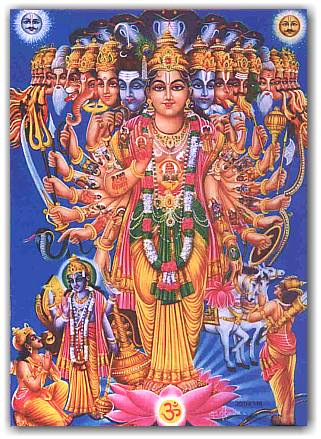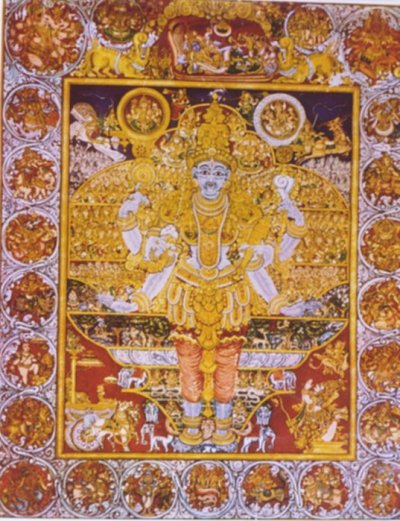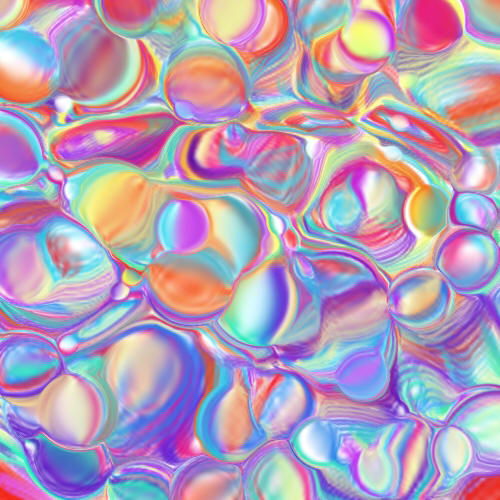The Vision of the Cosmic Form continued...
So did Pandu's Son behold
All this universe enfold
All its huge diversity
Into one vast shape, and be
Visible, and viewed, and blended
In one Body - subtle, splendid,
Nameless - th' All-comprehending
God of Gods, the Never-Ending
Deity!
- Ganguli (XI.13)
Existence is beyond the power of words to define, as Lao Tzu has wisely said. And yet Vyasa, the poet-author of the Bhagavad Gita in the Mahabharata, does a superb job of drawing our minds into the higher realms through the Vision of the Cosmic Form - the Visvarupa.
The Vision is both beautiful and terrifying. Arjuna sees the heavenly hosts, the throngs of gods (surasamghah) entering into the Cosmic Form. Some appear to be filled with fear, while others are reverent with hands joined in prayer (XI.21).
The astonishing sight of the Supreme Being - with many eyes and mouths, some having beastly tusk-like teeth (bahu-danstra), multiple arms, thighs, and feet - makes the worlds (lokas) tremble). The worlds shake at the exalted and dreadful sight of the Imperishable All - and so does Arjuna (XI.23)
 These
see Thee, and revere
These
see Thee, and revere
In sudden-stricken fear;
Yea! the Worlds, - seeing Thee with form stupendous,
With faces manifold,
With eyes which all behold,
Unnumbered eyes, vast arms, members tremendous,
Flanks, lit with sun and star,
Feet planted near and far,
Tusks of terror, mouths wrathful and tender; -
The Three wide Worlds before Thee
Adore, as I adore Thee,
Quake, as I quake, to witness so much splendour!
- Ganguli (XI.23)
Arjuna confesses that the Vision of Krishna’s Cosmic Form has caused his heart to lose all courage and his mind to lose its peaceful equilibrium. The greatest warrior in the world is reduced to trembling before the Lord of all the Worlds, whose form touches the sky and whose countless enormous eyes are filled with fire. ‘Thus blinded by the brilliance of a million suns’ (Shyam Ghosh), Arjuna has lost his sense of direction. No longer knowing East from West, he asks for Mercy.
The Vision becomes more horrifying, ghastly and unnerving. Arjuna watches as his enemies, those warriors who were once his friends and family, who now wait on the battlefield for war, one by one move quickly into the open mouths of the Divine Form and are devoured. He sees Dhritarashtra’s one hundred sons, his teachers Bhishma and Drona, and the blameless Karna - who as yet unknown to Arjuna is his own brother - all being crushed in the monstrous tusk-like teeth.
Crushed under its large & frightful teeth
The Visvarupa, with its many heads, then becomes the personification of ‘Death - with its wide, gaping mouth sucking in an unending stream of men and women who, crushed under its large and frightful teeth, seemed to vanish behind flaming tongues of fire!’ (Shyam Ghosh)
Some of these can be seen stuck between the teeth (danstra) with their heads crushed. These gruesome vicious tusks remind Arjuna of the fires at the Time of the Dissolution (XI.25-27).
The Kings and Chiefs drawn in,
That gaping gorge within;
The best of both these armies torn and riven!
Between Thy jaws they lie
Mangled full bloodily,
Ground into dust and death! Like streams down-driven
With helpless haste, which go
In headlong furious flow
Straight to the gulfing deeps of th' unfilled ocean,
So to that flaming cave
Those heroes great and brave
Pour, in unending streams, with helpless motion!
Like moths which in the night
Flutter towards a light,
Drawn to their fiery doom, flying and dying,
So to their death still throng,
Blind, dazzled, borne along
Ceaselessly, all those multitudes, wild flying!
Thou, that hast fashioned men,
Devourest them again,
One with another, great and small, alike!
The creatures whom Thou mak'st,
With flaming jaws Thou tak'st,
Lapping them up! Lord God! Thy terrors strike
From end to end of earth,
Filling life full, from birth
To death, with deadly, burning, lurid dread!
Ah, Vishnu! make me know
Why is Thy visage so?
Who art Thou, feasting thus upon Thy dead?
- Ganguli
It is in verses XI.24 & 30 that Arjuna addresses Krishna’s Cosmic Form as Vishnu, the all-pervasive deity. Krishna is an incarnation of Vishnu, the god that sustains and protects the worlds.
लेलिह्यसे
ग्रसमानः
समन्ताल्-
लोकान्समग्रान्वदनैर्ज्वलद्भिः
.
तेजोभिरापूर्य
जगत्समग्रं
भासस्तवोग्राः
प्रतपन्ति
विष्णो
.. ११-
३०..
lelihyase grasamānaḥ samantāl
lokān samagrān vadanair jvaladbhiḥ
tejobhir āpūrya jagat samagraṃ
bhāsas tavogrāḥ pratapanti viṣṇo 11.30
In ‘The Betrayal of Krishna’ the Indian scholar Krishna Chaitanya/KK Nair says that the relationship between ‘God and his manifestations was cleared’ by Krishna’s ‘extraordinary and full-blooded vitality in the epic (The Mahabharata); and gave the term Avatar a richer meaning: Krishna’s “historicity” contributed to the stabilization of the concept [of Avatar], which was then extended to apply to other “incarnations”, more full-bodied than mere “manifestations”.’
Krishna Chaitanya/KK Nair points outs that ‘the personal elevation of a popular tribal hero or god to such supreme status in this manner is Vyasa’s personal rehandling of myth; and the whole strategy was poetic, not theological or cultist.’
Krishna as an Incarnation of Vishnu
 In the
beginning verses of the Mahabharata, Vishnu is bowed to with reverence by the
Bard Sauti. In this moment Vishnu emerges as an aspect of the All (M.N.Dutt;
The Adi Parva Ch.1.22-24). The Bard speaks in reverence to the ‘original first
being’ whose is named Ishana. Ishana is one of the older names for the god
Shiva, whose earlier name was Rudra (Judith M.Tyberg). The word Shiva comes
from ‘auspicious’ (A.Danielou).
In the
beginning verses of the Mahabharata, Vishnu is bowed to with reverence by the
Bard Sauti. In this moment Vishnu emerges as an aspect of the All (M.N.Dutt;
The Adi Parva Ch.1.22-24). The Bard speaks in reverence to the ‘original first
being’ whose is named Ishana. Ishana is one of the older names for the god
Shiva, whose earlier name was Rudra (Judith M.Tyberg). The word Shiva comes
from ‘auspicious’ (A.Danielou).
Ishana/Shiva is said to be ‘the true unchangeable One, who is manifested and unmanifested, eternal and everlasting Brahma’ (M.N.Dutt). Therefore Ishana/Shiva is Brahma. The Bard’s honor and praise continues for Brahma, who is ‘both non-existing and existing-non-existing, who is the (existing) universe and still distinct from both the existing and non-existing world, who is the originator of all, both high and low.’
Trimurti
Thus Ishana/Shiva is Brahma, who is the originator of all, existing and non-existing, high and low. And Ishana/Shiva, who is Brahma, ‘who is the ancient great undecaying One who is Vishnu ...’(M.N.Dutt). So Ishana/Shiva is Brahma is Vishnu. The three primary personifications of primordial metaphysical principles - the Trimurti - are in fact the One.
Vishnu is ‘the good and the goodness, who is worthy of all worship, pure and sinless, who is Hari ...’ (M.N.Dutt). Hari is a Sanskrit word which is used to name Krishna. Hari means the one who removes sin - sin being ignorance of the Real.
Shiva - Brahma - Vishnu - Krishna - Hari
The significance of my quoting the reverential opening verses in the Mahabharata is to convey the idea of the One in the many. Hinduism understands that the One assumed the appearance of multiplicity to enjoy this universe. From the very first pages of the Mahabharata, the poet-author Vyasa is clearly telling us that the One is the All.
The Infinite, Immeasurable, Imperishable One is described by a multitude of names which define specific qualities. All the gods and goddesses are personifications of those primordial metaphysical principles that constitute the worlds and the diverse energies in our chakras. They are the varied expressions of the One. Brahma is the guna rajas, Shiva the guna tamas, and Vishnu the guna sattva.
Soma
Hari also means ‘tawny’ which is said to be one of the colors of the elixir Soma. No one seems to know anymore exactly what Soma was, but it was used as a part of early Vedic tradition and is described in the Rig Veda and the Upanishads.
Soma is the ‘divine delight hidden in all existences’ (Judith M.Tyberg). The gods, especially Indra, feed on Soma and its action is to produce ‘an intoxicated ecstasy of inspiration by which the rays of light come pouring abundantly and joyously in.’
Bhang!
These days Bhang is sometimes used in Northern India. A surprising sequence in an otherwise uneven the Bollywood film ‘Yeh Raaste Hain Pyaar Ke’ (The Path of Love), staring Ajay Devgan, Madhuri Dixit, and Priety Zinta, paints a rather Busby Berkeley picture of an elaborate, exuberant and fun ceremony involving the imbibing of large pots of liquid greenish Bhang.
My feeling is that the real Soma described in these ancient Sanskrit texts was a consequence of and only possible in the previous cycles of time or perhaps the Dvapara Yuga. A natural herb or any material substance that gives human consciousness access to the highest Divinity would not have survived the lowered ever more dense frequencies and the solidification of matter that took place over the span of the Kali Yuga.
By this statement, you may infer my opinion of the popular current molecules which purport to open the doors of perception. Yes, they offer a variety of experiences and visions of a variety of realms. However all that glitters is not gold, and many of these worlds are simply more of the temporal illusory realms created by the mind of man over the cycles of time.
The heat of the fire ...
In ancient times Soma was treated with respect. Those who drank the juice had to prepare and develop ‘the necessary in discipline’ (Judith M.Tyberg). The Rig Veda contains this warning:
He tastes not that delight who is unripe and whose body has not suffered the heat (tapas) of the fire; they alone are able to bear that and enjoy it who have been prepared by the flame.
- Rig Veda IX.83.1
The warning is clear. Those who have not prepared themselves mentally and physically, and who have not purified their consciousness by the fires (tapas) of Knowledge will not truly benefit from drinking the Soma. Perhaps as the old saying goes, they will go on a bad trip!
Krishna as the Incarnation of Vishnu
 Krishna
is said to be an incarnation of the deity Vishnu. In his introduction to the
Mahabharata, the scholar M.N.Dutt says that Krishna is ‘the most intriguing
figure in the Mahabharata ... He belongs to a primitive tribe of cowherds. By
some process of apotheosis [being elevated to divine status], he became the
Supreme Being of the Bhagavad Gita ... an Acharya [spiritual teacher] of
Karma
Yoga ... a great Yogi.’
Krishna
is said to be an incarnation of the deity Vishnu. In his introduction to the
Mahabharata, the scholar M.N.Dutt says that Krishna is ‘the most intriguing
figure in the Mahabharata ... He belongs to a primitive tribe of cowherds. By
some process of apotheosis [being elevated to divine status], he became the
Supreme Being of the Bhagavad Gita ... an Acharya [spiritual teacher] of
Karma
Yoga ... a great Yogi.’
The more you read about Krishna, the more you come to like him and it is easy to understand why he is so popular in India. Krishna is perfect! He is exceedingly handsome, intelligent, brave, sensitive, cosmic, fun, and wise. Because of my love for the wisdom in the Bhagavad Gita, I have grown to love Krishna and consider him as my greatest teacher. However, I do believe that there is a pernicious trap in placing any being beyond reach. Krishna says that God dwells within the Heart of every man, woman, and child - not just in Krishna’s Heart!
In his brilliant book The Betrayal of Krishna the Indian scholar Krishna Chaitanya/KK Nair says:
That kind of devotion where it is believed that man should be more and more belittled in order that deity be more and more exalted leads to authoritarian creeds and to pathology.
Krishna Chaitanya/KK Nair quotes Eric Fromm is this regard:
... the alienation from his own powers not only makes man slavishly dependent on God, it makes him bad too. He becomes a man without faith in his own fellow men or himself, without the experience of his own love, of his own power of reason.
If we are foolish enough to place any expression of the One so far beyond and above us, then we eventually become the consciousness that does not know that were are this Is-ness. As the Brihadaranyaka Upanishad (I.iv.10) says, ‘...if a man worships another deity thinking: He is one and I am another, he does not know.’ This frequency of consciousness gets us as far from the Satya Yuga - the golden era when we all knew that God dwells within us - as the Kali Yuga can possibly drag us!
Not what Krishna & Vyasa hoped for us ...
This slavish, obsequious, authoritarian attitude would never have been what Krishna and Vyasa hoped for us. For such a fragmented sad state would effectively separate us from ever Knowing our real identity and prevent us from achieving the similitude (sadharmya) with the God-within that Krishna wants for us.
It is only this conscious awareness of similitude (sadharmya) that can provide the contentment which is a source of power for us, so that we can begin to work for the well-being of the world (lokasamgraha). Krishna’s primary concern, the reason why he came here as an incarnation of the sattvic deity Vishnu, who sustains and supports the world, is this very lokasamgraha.
Hindu Concept of Life & Death
As portrayed in Vedas, Brahmanas, Aranyakas, Upanishads, Smrtis & Epics
A Survey & Exposition by Shyam Ghosh (born 1904)
Munshiram Manoharlal Publishers, 1989, New Delhi
The Language of the Gods
Sanskrit Keys to India’s Wisdom
Judith M.Tyberg
East-West Cultural Center, 1970; Los Angeles, CA
